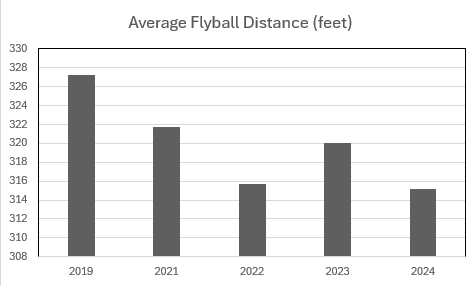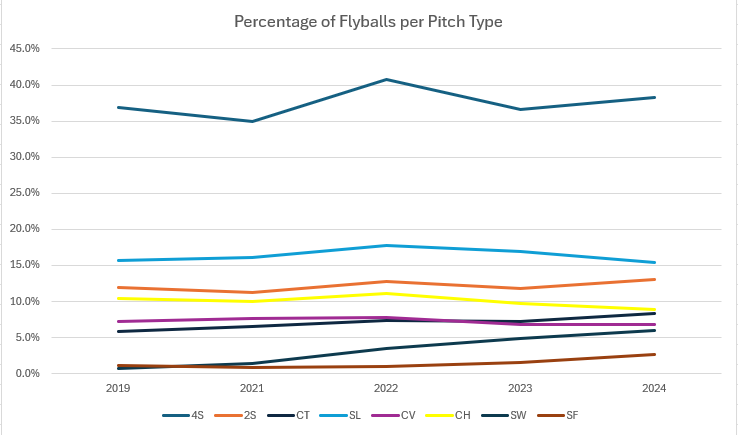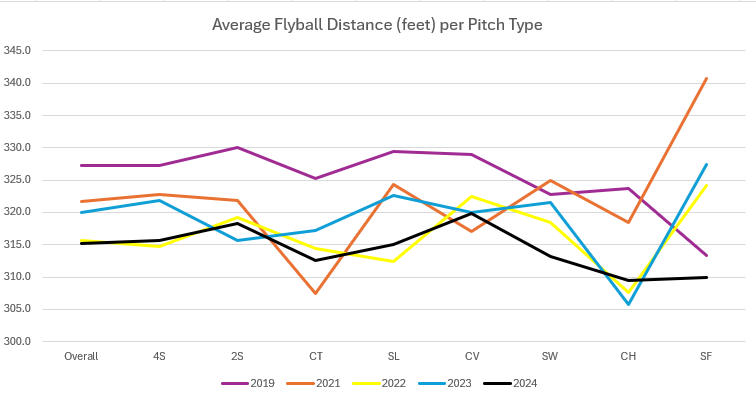This article is part of our The Z Files series.
If it's not clear by now, I'm obsessed with the current run-scoring landscape and how to incorporate it into the management of our fantasy baseball rosters. In fact, this week's Tout question is:
How, if at all, has the current dead-ball landscape affected your in-season management?
There are still a few days before the replies will be posted (ETA Friday afternoon on the Tout Wars site.) However, a couple of the early responses caught my eye. There were some suggestions that the ball is traveling as usual in June, and the decline in flyball distance could be a change in pitch distribution where fewer fastballs are being thrown, so batters must supply more of the power.
Challenge accepted!
Let's start with the basics. Here is the data for action from June 1 through June 17 for the past few seasons:
| YEAR | K% | BB% | HR% | Runs per Game | BABIP |
|---|---|---|---|---|---|
| 2019 | 22.5% | 8.2% | 3.6% | 4.96 | 0.297 |
| 2021 | 23.2% | 8.3% | 3.4% | 4.70 | 0.295 |
| 2022 | 21.6% | 7.9% | 3.1% | 4.58 | 0.291 |
| 2023 | 22.6% | 8.6% | 3.0% | 4.44 | 0.293 |
| 2024 | 21.7% | 8.0% | 3.0% | 4.46 | 0.292 |
So far this month, homers and scoring are on a par with last season. It's interesting to note that there are fewer strikeouts and walks in June this season. This is more of an observation than an actionable item, but it could become important if the trend continues.
Here is the average flyball distance for the first 17 days of June:
| YEAR | Avg FB Dist |
|---|---|
| 2019 | 327.2 |
| 2021 | 321.7 |
| 2022 | 315.7 |
| 2023 |
If it's not clear by now, I'm obsessed with the current run-scoring landscape and how to incorporate it into the management of our fantasy baseball rosters. In fact, this week's Tout question is:
How, if at all, has the current dead-ball landscape affected your in-season management?
There are still a few days before the replies will be posted (ETA Friday afternoon on the Tout Wars site.) However, a couple of the early responses caught my eye. There were some suggestions that the ball is traveling as usual in June, and the decline in flyball distance could be a change in pitch distribution where fewer fastballs are being thrown, so batters must supply more of the power.
Challenge accepted!
Let's start with the basics. Here is the data for action from June 1 through June 17 for the past few seasons:
| YEAR | K% | BB% | HR% | Runs per Game | BABIP |
|---|---|---|---|---|---|
| 2019 | 22.5% | 8.2% | 3.6% | 4.96 | 0.297 |
| 2021 | 23.2% | 8.3% | 3.4% | 4.70 | 0.295 |
| 2022 | 21.6% | 7.9% | 3.1% | 4.58 | 0.291 |
| 2023 | 22.6% | 8.6% | 3.0% | 4.44 | 0.293 |
| 2024 | 21.7% | 8.0% | 3.0% | 4.46 | 0.292 |
So far this month, homers and scoring are on a par with last season. It's interesting to note that there are fewer strikeouts and walks in June this season. This is more of an observation than an actionable item, but it could become important if the trend continues.
Here is the average flyball distance for the first 17 days of June:
| YEAR | Avg FB Dist |
|---|---|
| 2019 | 327.2 |
| 2021 | 321.7 |
| 2022 | 315.7 |
| 2023 | 320.0 |
| 2024 | 315.2 |

The ball's flight is still restricted relative to previous seasons for this time of the season. As such, flyball pitchers still benefit, while flyball hitters may continue to underperform expectations.
Let's get granular and observe the results per pitch type. But first, here's a look at the percentage of flyballs generated by the different offerings from the prior few seasons.
- 4S: Four-Seam Fastball
- 2S: Two-Seam Fastball
- CT: Cutter
- SL: Slider
- CV: Curveball
- CH: Changeup
- SW: Sweeper
- SF: Split-Finger Fastball
| YEAR | 4S | 2S | CT | SL | CV | CH | SW | SF |
|---|---|---|---|---|---|---|---|---|
| 2019 | 36.8% | 12.0% | 5.9% | 15.7% | 7.2% | 10.5% | 0.7% | 1.2% |
| 2021 | 34.9% | 11.2% | 6.6% | 16.1% | 7.6% | 10.0% | 1.5% | 0.9% |
| 2022 | 40.8% | 12.8% | 7.3% | 17.8% | 7.8% | 11.2% | 3.5% | 1.0% |
| 2023 | 36.6% | 11.8% | 7.2% | 17.0% | 6.8% | 9.7% | 4.8% | 1.5% |
| 2024 | 38.2% | 13.0% | 8.3% | 15.4% | 6.8% | 8.9% | 6.0% | 2.7% |

The four-seam fastball is designed to be hit in the air, and sure enough, far more four-seamers are elevated than any other pitch. Keep in mind, this is not the overall distribution, but rather the level of flyballs generated by each pitch. Even so, it puts the kibosh on the notion that there are more flyballs on off-speed pitches, potentially lowering the distance. Of the years studied, only in 2022 was there a higher percentage of flyballs emanating from four-seam fastballs.
There still could be merit to the pitch distribution theory if the distance resulting from each pitch were different.
| YEAR | Overall | 4S | 2S | CT | SL | CV | SW | CH | SF |
|---|---|---|---|---|---|---|---|---|---|
| 2019 | 327.2 | 327.3 | 330.1 | 325.2 | 329.4 | 329.0 | 322.8 | 323.7 | 313.4 |
| 2021 | 321.7 | 322.8 | 321.9 | 307.4 | 324.3 | 317.1 | 325.0 | 318.5 | 340.8 |
| 2022 | 315.7 | 314.7 | 319.2 | 314.4 | 312.4 | 322.4 | 318.4 | 307.6 | 324.2 |
| 2023 | 320.0 | 321.9 | 315.7 | 317.2 | 322.6 | 320.0 | 321.6 | 305.7 | 327.4 |
| 2024 | 315.2 | 315.7 | 318.3 | 312.5 | 315.1 | 319.9 | 313.2 | 309.5 | 310.0 |

With the exception of the changeup, 2024 exhibits the shortest or second shortest average flyball distance for each pitch. Changeups land in the middle, but the decline isn't nearly sufficient to drive the overall drop.
Other than wanting to vet some of the comments from my fellow Touts, I wanted to run these numbers in advance of a heatwave being experienced by the Northeast. Granted, it's been warm in other parts of the country, but it's been rather cool in New England and the Mid-Atlantic until now. Not all of those teams are home this week, but even so, I wanted some data before the mercury boiled over.
Answering the question posed to the Touts (How, if at all, has the current dead ball landscape affected your in-season management?), it's important to keep in mind everything is relative. Sure, pitching ratios are lower, but they're lower for everyone. The key is to identify the pitchers who benefit most from the current environment. Specifically, flyballs are yielding fewer homers as well as fewer overall hits. A lower percentage of runs are scored via the long ball. As such, teams need to keep the line moving to score. The landscape clearly benefits flyball pitchers, but the type of pitchers taking the most advantage is actually the low-walk, low strikeout types. This is the group we usually fear to roster, as pitching to contact always invites batted ball variance, but I am less concerned about regression for Seth Lugo, Jake Irvin, Tanner Houck and Chris Paddack. Zach Eflin, Bailey Ober and Zack Littell should post a better ERA for the rest of the season. Miles Mikolas, Slade Cecconi and Nick Martinez are less scary as streamers.









